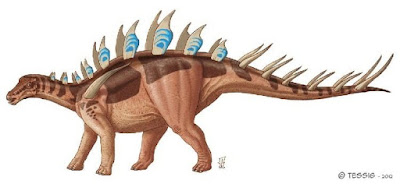Type Species: Lexivosaurus durobrivensis
Classification: Dinosauria – Ornithischia – Thyreophora – Stegosauria
Time Period: Middle Jurassic
Location: Europe (England, France)
Diet: Herbivore
Lexivosaurus is the first of the ‘standard-looking’ stegosaurs that would rise to prominence in the Late Jurassic. It’s been found in England and France, though it’s more common in England. The first discoveries were made near Lyons, France, and the fossil remains belonged to three individuals and included isolated bits of bones, plates, and spikes. The three individuals were a range of ages, from juvenile to adult, indicating a family group. Lexivosaurus’ name comes from the Lexovix people, one of the ancient Gallic tribal groups from what is now Lyons, France.
Lexivosaurus was smaller than later stegosaurs, but it was ‘small’ only in comparison: it reached sixteen and a half feet long and weighed around two tons. It was a low-browsing herbivore that roamed the wooded islands that were scattered throughout the shallow seas of prehistoric Europe. Lexivosaurus has back plates that run from its neck to its tail; these plates are narrow and short rather than broad and angular, and it had several pairs of long spikes on the tail. These were likely defensive weapons used against attacking predators such as Magnosaurus, Poekipleuron, and Megalosaurus. Another defensive weapon was the meter-long shoulder spikes that projected from the upper rear part of the front limbs, below the characteristic twin rows of bony plates along the top of its neck and back. While older reconstructions of Lexivosaurus place the spines on the hips, modern paleontologists tend to put them on the shoulders. These spikes may have been used as visual displays – for courtship, fighting rival mates, or species identification – or they may have been defensive weapons, like the tail spikes. If a predator were attacking from the front, Lexivosaurus could thrust itself forward, driving the spikes into the flesh of its assailant.


No comments:
Post a Comment